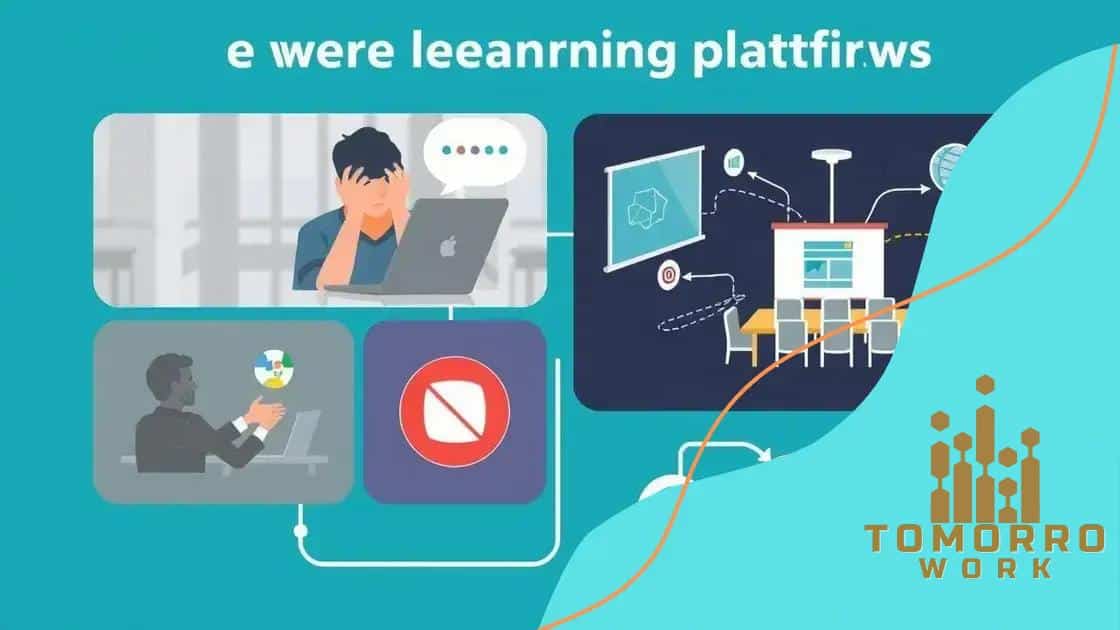The future of e-learning platforms in higher education

Advertisements
The future of e-learning platforms in higher education will focus on personalized learning, enhanced engagement through technology, and the integration of virtual reality, making education more accessible and relevant to diverse learners.
The future of e-learning platforms in higher education is not just a trend; it’s a transformation. Have you ever thought about how these platforms could redefine your learning experience? In this article, we’ll dive into what’s ahead for e-learning.
Advertisements
Emerging trends in e-learning technology
Emerging trends in e-learning technology are reshaping the way students interact with their education. As the world becomes more digital, it’s important to recognize how these innovations are impacting higher education.
One major trend is the increase in adaptive learning systems. These platforms use data analytics to tailor educational experiences to individual students’ needs. This means that everyone can learn at their own pace, improving overall engagement and performance.
Mobile Learning
Another exciting development is the rise of mobile learning. With smartphones and tablets, students can access their coursework anytime and anywhere. This convenience helps learners fit education into their busy schedules.
Advertisements
Gamification
Gamification is also gaining popularity in e-learning. By incorporating game-like elements into lessons, educators can motivate students and make learning more enjoyable. This approach has shown positive results in student participation.
Additionally, the use of virtual reality (VR) and augmented reality (AR) is becoming common in educational settings. These technologies provide immersive learning experiences that can enhance understanding and retention of complex subjects.
Social Learning
Another key trend is the emphasis on social learning. These platforms encourage communication and collaboration among students, creating vibrant online communities. Here are some benefits of social learning environments:
- Increased motivation among peers
- Better retention of information
- Access to diverse perspectives
As we look toward the future, it’s clear that these emerging trends in e-learning technology will continue to evolve. Understanding and embracing these changes is essential for both educators and students.
Benefits of e-learning in higher education
The benefits of e-learning in higher education are numerous and significant. Students today have access to a world of knowledge at their fingertips. This accessibility allows for a flexible learning environment catered to individual needs.
One major benefit is the ability to learn at one’s own pace. Unlike traditional classrooms, e-learning platforms enable students to revisit lectures and course materials as needed. This self-directed learning style leads to better retention and understanding of the material.
Cost-effectiveness
E-learning can also be much more cost-effective for students. With reduced transportation and material costs, students can save money while still receiving a quality education. Here are some key financial advantages:
- Lower tuition fees compared to traditional institutions
- No commuting expenses
- Reduced costs for textbooks and materials
Another exciting aspect is the diversity of courses available. Students can study a wide range of subjects from top institutions worldwide without geographical limitations. This expands opportunities for students, allowing them to find programs that truly match their interests and career goals.
Enhanced Learning Experience
Furthermore, many e-learning platforms utilize multimedia tools to create engaging and interactive lessons. Videos, quizzes, and discussion forums enhance the learning experience. These elements cater to different learning styles, making education more inclusive.
The flexibility of e-learning also allows students to balance their studies with work, family, or other commitments. This adaptability fosters a sense of responsibility and self-management among learners. In essence, e-learning is revolutionizing higher education, making it more accessible, affordable, and relevant for today’s students.
Challenges faced by e-learning platforms

Challenges faced by e-learning platforms are significant as they strive to provide effective education. One major hurdle is the **digital divide**. Not all students have equal access to the necessary technology or high-speed internet. This inequality can hinder learning opportunities for many.
Another challenge is ensuring student engagement. Online learning can sometimes feel isolating, leading to decreased motivation. Teachers must find ways to keep students involved and connected. This can include interactive content, discussions, and feedback.
Technical Issues
Technical difficulties also pose a problem for both students and educators. Glitches, slow loading times, and software malfunctions can disrupt the learning process. To mitigate these problems, platforms must invest in reliable technology and support systems.
Quality Assurance
Another concern is the quality of online courses. With so many options available, it can be challenging to determine which courses offer valuable content. Here are some factors that contribute to quality assurance:
- Qualified instructors with adequate training
- Regular updates to course material
- Feedback mechanisms for continuous improvement
Additionally, maintaining a sense of community in a virtual environment is crucial. Students often miss the social interactions that occur in traditional classrooms. E-learning platforms need to foster connections among students through group projects, forums, and networking opportunities.
With these challenges in mind, e-learning platforms must adapt and innovate to create engaging, accessible, and high-quality education for all students.
Comparing traditional and online learning methods
Comparing traditional and online learning methods reveals key differences that influence how students interact with education. In a traditional classroom, students often attend lectures in person, allowing for direct interaction with teachers and peers. This face-to-face connection fosters a sense of community but can sometimes limit flexibility.
On the other hand, online learning provides students with the freedom to study at their own pace. They can access course materials anytime and anywhere. This flexibility allows learners to manage their time better, especially for those balancing work or family commitments.
Interaction and Communication
Interaction styles also differ between the two methods. In traditional settings, students may ask questions directly in class or during office hours. In contrast, online platforms often rely on discussion boards and emails for communication. While these tools can facilitate rich discussions, they can sometimes feel less personal.
Learning Materials
Additionally, the types of learning materials available vary significantly. Traditional classrooms typically use textbooks and physical resources, while online learning uses multimedia tools such as videos, podcasts, and interactive quizzes. This variety in online materials can enhance understanding but may overwhelm some students.
Moreover, assessment methods differ. Traditional courses often involve exams and in-person presentations, while online courses use quizzes, forums, and project submissions to evaluate learning. These diverse approaches can cater to different learning styles, maximizing student engagement.
Finally, the cost factor is worth considering. Traditional education often involves tuition fees, commuting costs, and materials. Online learning tends to be more affordable by eliminating these expenses, making education more accessible to many.
Future predictions for e-learning in academia
Future predictions for e-learning in academia suggest exciting developments that can transform the landscape of education. As technology continues to evolve, we can expect increased personalization of learning experiences. Instructors will use data analytics to tailor content to the specific needs of each student, enhancing engagement and outcomes.
Another trend is the rise of artificial intelligence in e-learning platforms. This technology can help automate administrative tasks, provide instant feedback, and create intelligent tutoring systems that respond to individual learner needs.
Expansion of Virtual and Augmented Reality
Moreover, the expansion of virtual reality (VR) and augmented reality (AR) in education is on the horizon. These technologies offer immersive learning experiences that allow students to explore complex subjects in engaging ways. For example, medical students could perform virtual surgeries, while history students could take virtual field trips to significant historical sites.
Focus on Lifelong Learning
The trend towards lifelong learning will also shape the future of e-learning. As the job market continues to change rapidly, there’s a growing need for professionals to upskill and reskill continuously. E-learning platforms will adapt by offering flexible, bite-sized courses that cater to busy adults looking to advance their careers.
Additionally, a greater emphasis on collaboration and community in online environments is likely. Developers will design platforms that foster social interaction among students, creating a sense of belonging and support. This will help counter the isolation often felt in online learning.
Finally, the integration of blockchain technology may enhance e-learning credibility. By providing secure and verifiable records of achievements, blockchain could revolutionize credentialing in higher education.
FAQ – Frequently Asked Questions about the Future of E-Learning in Academia
What are some key benefits of e-learning in higher education?
E-learning offers flexibility, personalized learning experiences, and access to diverse courses from anywhere in the world.
How is artificial intelligence changing e-learning platforms?
Artificial intelligence enhances e-learning by providing tailored feedback, automating administrative tasks, and improving student engagement.
What role do virtual and augmented reality play in education?
VR and AR create immersive experiences that help students understand complex topics by bringing lessons to life.
Why is lifelong learning important in today’s job market?
Lifelong learning helps individuals continuously upskill and adapt to rapidly changing job requirements, keeping them competitive.





